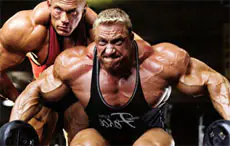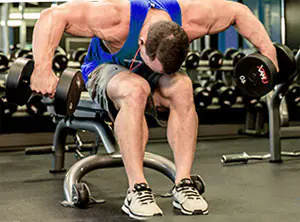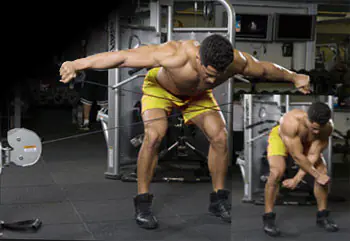One of the main signs of a cool “jock” is broad shoulders, and the width of the shoulders directly depends on the volume of the chest and the level of hypertrophy of the deltoid muscles.
We have already told you about the chest in our previous reviews, so in this article we will focus our gaze on the shoulders. Of course, the bulk of their weight comes from the middle and front bundles. But as often happens, the athlete looks spectacular from the front, his shoulders are pumped up and wide. Then he turns sideways, and the effect is immediately blurred, there is no real power, a rounded, complete shape of the deltoids. The reason for this disharmony is the insufficient development of the posterior bundle. There are no trifles in bodybuilding, and without pumping even such a small muscle you will not achieve success. In addition, developed dorsal deltoids enhance the impression of a powerful back when posing.
The reason for the back lag is that this muscle is involved very little in normal physical activity, since only a few movements involve it in direct work. Take a closer look at powerlifters - powerful guys with huge muscles of the chest, back, arms... and with a small, undeveloped rear deltoid. They just don’t need it in this sport. Of course, the posterior bundle receives some load, for example, when pulling dumbbells to the belt or raising your arms to the sides, but it is scanty and clearly insufficient for hypertrophy. And therefore, you just have to take on the necessary exercises aimed precisely at this zone, and it will immediately respond to the load with its qualitative growth...
Therefore, the question: how to pump up the rear delts has an excellent solution, subject to proper focused training. Unfortunately, there are few movements that specifically develop the dorsal bundle. More precisely, there is only one thing - this is raising the arms to the sides in an incline, however, in various variations, which we will consider below. Some athletes claim that barbell rows to the chin also “pump” this muscle, but the conversation here again is only about indirect loads.
So, we present to your attention exercises for pumping up the rear delts. Include them in your main shoulder workout, varying the order of execution in each session to avoid stagnation. And, since this muscle group is small in size and is little involved in other movements, it will respond very well to a high number of repetitions. For example, this option is 4 series of 12-15 repetitions.
- Raising arms while sitting in an inclined position. Bend over until your body touches the front of your thigh. While lifting dumbbells, try not to lift your torso from your legs, otherwise you will end up with unwanted cheating. Raise your arms as high as possible for the greatest reduction of deltas. Watch your breathing: lift the dumbbells, overcoming resistance, with an exhalation, lower them with an inhale. In exercises for the dorsal bundle, precision of movements is very important; raise your arms to the sides, do not throw them back. Unfortunately, the sitting option is not suitable for all athletes. If you have a tummy, you will have difficulty breathing due to constriction of the diaphragm.
- Raising arms while standing on an incline. Bend your knees slightly, hold your torso at a slight angle to the horizontal, hold the dumbbells parallel to your feet (although variations up to perpendicular placement are possible). Perform the movement slowly, with short-term fixation at the top point. The negative phase is also very important, do not throw your arms down, lower them, resisting the weight of the projectiles.
- Raising your arms while lying on a horizontal bench. A very good exercise option. Since there is no need to be distracted by maintaining balance, you can work with full dedication. The only important point is that the bench should be narrow enough to allow the shoulders to hang down, but high enough to allow full range of motion. We recommend experimenting with the position of your hands. Try turning your hands a little outward, with your little fingers up, and you will feel how the mechanics of movement change, and the rear deltoids simply begin to tremble from tension.

- Bent-over block flyes. For this variation, we use the lower handles of the block frame simulator. The positive aspects of this version of the exercise include a constant load on the target muscles and absolute safety from injury.
- Another good recipe for pumping up the beam in question is a specialized simulator for raising your arms back from a sitting position. Usually this is a combined machine that also allows you to pump the pectoral muscles, depending on the position of the athlete: back to back or facing towards it. You sit on the bench of the machine, pressing your chest against the above vertical backrest, having previously adjusted the position of the handles to suit your anatomy. Firmly grasp the handrails and, overcoming resistance, move them in an arc behind your back to the maximum possible amplitude. Try not to lift your chest from the vertical surface. The advantage of such work is the complete absence of at least some elements of cheating, as well as absolute control over the movement being performed - for example, you can perform it extremely slowly, feeling the constant tension of the target group. An excellent simulator - we recommend it for use.



